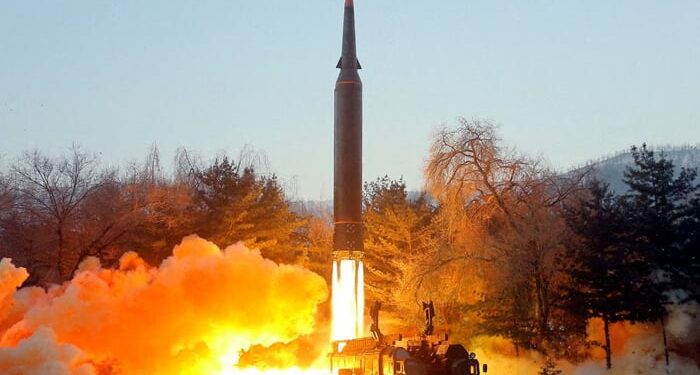North Korea launched two ballistic missiles on 01 July with the second missile reportedly failing and potentially scattering debris inland, according to South Korea’s military. These launches occurred a day after North Korea vowed “offensive and overwhelming” responses to recent military drills conducted by the United States, South Korea, and Japan.
The missiles were fired from Jangyon, a town in southeastern North Korea, in a northeasterly direction, ten minutes apart. South Korea’s Joint Chiefs of Staff stated that the first missile traveled 600 kilometers (370 miles), while the second missile flew 120 kilometers (75 miles). The landing sites were not specified, but it was noted that the second missile’s flight distance was insufficient to reach North Korea’s eastern waters, where such tests are usually aimed.
Joint Chiefs of Staff spokesperson Lee Sung-joon mentioned in a briefing that the second missile seemed to have encountered problems, possibly exploding and scattering debris on the ground. South Korean media, citing military sources, suggested it was highly likely that the second missile crashed in an inland area of North Korea. The first missile was believed to have landed in the waters off Chongjin, a city in eastern North Korea.
The missile launches coincided with the conclusion of the “Freedom Edge” drills, three-day multi-domain military exercises involving the US, South Korea, and Japan. North Korea often perceives such drills as rehearsals for an invasion and as proof of hostility from these countries.
Leif-Eric Easley, a professor of international studies at Ewha Womans University in Seoul, noted that North Korea’s actions align with its strategic approach to both politics and military policy. “In both North Korean politics and military policy, the best defense is often a good offense,” Easley commented. He emphasized that Pyongyang aims not to appear weak while South Korea conducts defense exercises with Japan and the United States.
This missile test follows another launch by North Korea five days earlier, where it claimed to have successfully tested a multiwarhead missile designed to defeat US and South Korean missile defenses. However, South Korean authorities disputed this, stating that North Korea likely tested a hypersonic missile that spiraled out of control and exploded.
The recent missile tests come amid a key ruling party meeting in North Korea. The meeting aims to address “important, immediate issues” to further enhance North Korea’s version of socialism. Observers noted that the meeting was ongoing as of 01 July.
These developments occur against a backdrop of heightened military activities and political maneuvers in the region. The United States, South Korea, and Japan’s joint military exercises are part of broader efforts to strengthen their defense capabilities against potential threats from North Korea. The trilateral military cooperation underscores the increasing alignment of these nations in countering North Korea’s military advancements and provocations.
North Korea’s missile tests, particularly those involving new or developmental weapons, are closely monitored by the international community. These tests are seen as part of Pyongyang’s strategy to enhance its military capabilities and exert pressure on its adversaries. The claims of advanced missile technologies, such as multiwarhead and hypersonic missiles, if verified, would signify significant advancements in North Korea’s missile program and pose new challenges to existing missile defense systems.
The ongoing tensions and military posturing highlight the complex security dynamics in Northeast Asia. North Korea’s aggressive stance and the corresponding military exercises by the US, South Korea, and Japan reflect the persistent volatility and the absence of diplomatic breakthroughs in the region. Efforts to engage North Korea in meaningful negotiations on denuclearization and peace have stalled, with Pyongyang continuing to prioritize its military development and security objectives.
The international community, particularly stakeholders in the region, faces the challenge of addressing North Korea’s provocations while seeking avenues for dialogue and reducing the risk of escalation. The recent missile tests and military drills underscore the urgency of finding a balanced approach that combines deterrence with diplomatic engagement to manage the security challenges posed by North Korea.
North Korea’s recent missile launches, including the suspected failure of the second missile, illustrate the ongoing tensions and strategic maneuvers in the region. As the US, South Korea, and Japan continue their military cooperation, North Korea remains committed to demonstrating its military capabilities and asserting its stance. The developments call for sustained international attention and efforts to address the underlying security concerns and promote stability in the region.
















